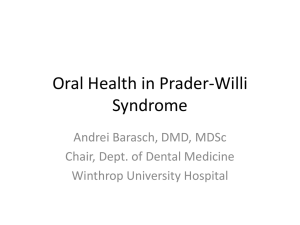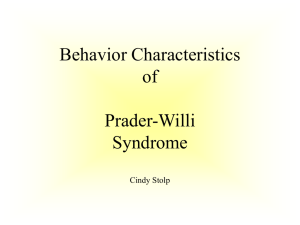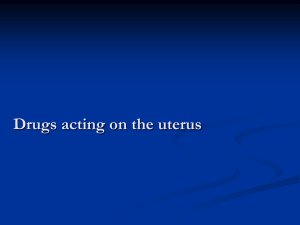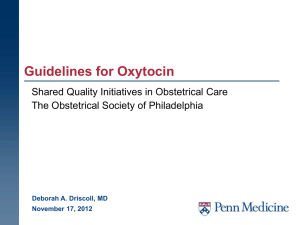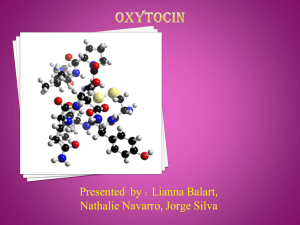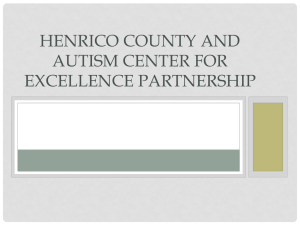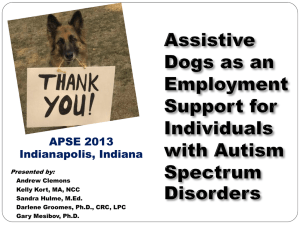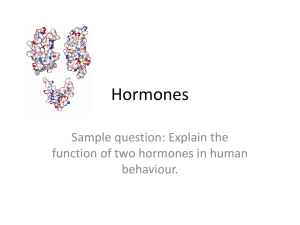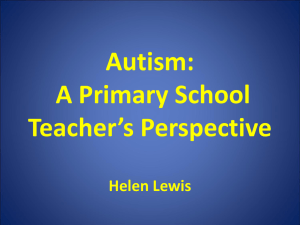Montefiore-Einstein Study Team, Internasal Oxytocin Presentation
advertisement
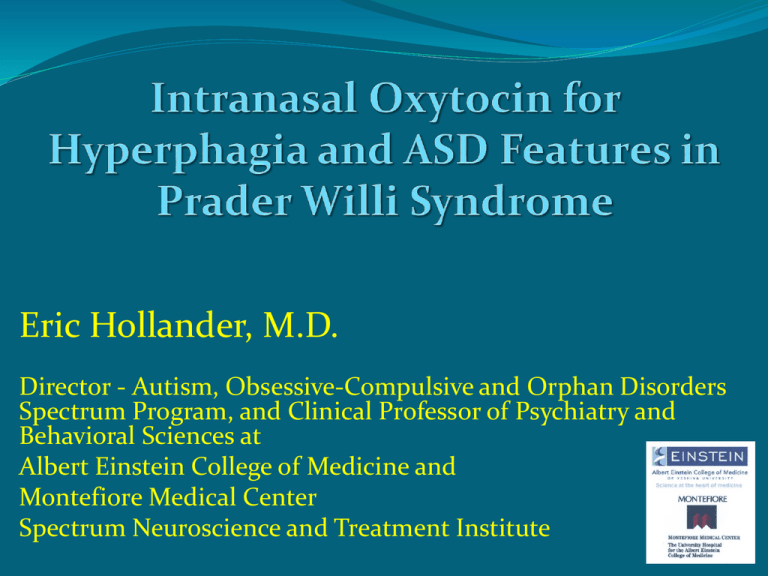
Eric Hollander, M.D. Director - Autism, Obsessive-Compulsive and Orphan Disorders Spectrum Program, and Clinical Professor of Psychiatry and Behavioral Sciences at Albert Einstein College of Medicine and Montefiore Medical Center Spectrum Neuroscience and Treatment Institute Montefiore-Einstein Study Team Casara Jean Ferretti MS Rachel Noone MD Bonnie P. Taylor PhD Ellen Doernberg BA Jessica Simberland MD Disclosures Foundation for Prader Willi Research Orphan Products Division– FDA (Autism, BDD, PWS, TSC) Simons Foundation (TSO, Temperature) Roche (V1a), Coronado Biosciences (TSO) NIMH, NINDS, NIDA NARSAD Distinguished Investigator award (OT) Neuropharm, Forest, Sunovion, IP - oxytocin and memantine in autism Experimental Therapeutics –ASD Oxytocin (and vasopressin 1a antagonists) Social communication domain, binge Immune-Inflammatory -TSO (cytokines) Repetitive behavior domain 5 Oxytocin personalized treatment for homogeneous disorders Prader-Willi Syndrome 15q11-13 paternal imprinting deletion Developmental neuropathology Oxytocin neurons (PVN to Post Pit to NA) Compulsive eating Intranasal OT for Compulsive Eating in PWS with Comorbid ASD Tuberous Sclerosis – mTOR-opathy Tubers, cell cycle disruption Rapamaycin is toxic Intranasal Oxytocin for TSC with Co-morbid ASD Prader-Willi Syndrome (PWS) Rare neurodevelopmental disease (1:15,000) Lack of expression of paternally derived imprinted material on chromosome 15q11-q13. Characteristics: Mild to moderate intellectual disability Severe hypotonia at birth Hyperphagia and risk of obesity Repetitive and compulsive behaviors Skin-picking Tantrums Social Cognition Deficits Hyperphagia develops after age 2 Prader-Willi Syndrome (PWS): Relationship to ASD 19% -25% have co-morbid ASD features 38% with ASD - maternal uniparental disomy (mUPD) of chromosome 15: No paternal input Overexpression of maternally-derived UBe3A Responsible for targeting proteins for degradation Most commonly observed autosomal abnormality in ASD (1-3% of cases) Prader-Willi Syndrome (PWS): Mechanism 25-30% patients with PWS have mUPD of chromosome 15 No paternal input and twice the amount of maternal genetic information 70% of PWS cases paternal deletion mutations of imprinted material is causal and about 2% are caused by imprinting errors of the paternally derived genetics material resulting in silencing of paternal genes Overexpression of maternally-derived UBe3A Responsible for targeting proteins for degradation Loss of antisense transcripts from paternal chromosome, usually represses UBe3A, results in further upregulation of expression Prader-Willi Syndrome (PWS): Oxytocin Decreased peripheral oxytocin decreased number OXT neurons in PVN of hypothalamus, smaller PVN volume Dysregulated oxytocin signaling - obesity Mice haploinsufficiency SIM1 - hyperphagic obesity, reduced OXT and MC4 receptors OXT decreases food intake and weight loss Prior Work with OT in PWS Single dose OT vs placebo– adult PWS Less disruptive behavior, increased trust decreased hunger, decreased food intake safety Chronic high dose in child/adults PWS increased temper tantrums on higher dose Use lower dose (16 iu BID) Model for how serotonin and PI3K signaling pathways interact via SLca4 and Pten to influence brain size, sociability, PPI, perseverative behaviors (Page et al, 10.1073/pnas.0804428106) Social deficits in autism Empathy (mind-blindness) Eye gaze Nonverbal communication Reciprocal interactions Oxytocin 9 aminoacid neuropeptide Synthesized in PVN and SON Peripheral release - delivery and lactation Central release - social cognition (recognition and memory), trust OXTR – PIK coupled Peripheral to central OT feed-forward system (Vasopressin –V1a-R) – reciprocal effects Wound Healing, Anti-inflammation Obesity Knockout Oxytocin Mice: Social Cognition Deficits (Ferguson et al, Nature Genetics, 2001) Vasopressin and Pair Bonds: Lessons from Prairie and Meadow voles (Lim et al , 2004) Prairie voles: highly affiliative, show partner preferences after mating Meadow voles: solitary, , do not say partner preferences Differences in social behaviors may be linked to differential expression of V1aR The Trust Game Kosfeld et al , 2005 Emotion matching task illustrates effects of oxytocin on amygdala (Source: NIMH Clinical Disorders Branch) Participants were asked to select, from the two faces on the bottom, the one that expressed the same emotion as the face on the top. Oxytocin Selectively Improves Empathic Accuracy -dynamic, naturalistic task: individualized response (Bartz, Hollander, et al. 2010) Targets for Oxytocin in Autism (from animal and healthy human studies) Social Recognition Social Affiliation Social Threat Amygdala and Fusiform activation Eye Gaze Social Memory Trust Social Anxiety Oxytocin and Social Cognition Affective Speech Recognition Measure Hollander et al, Biol Psych, 2006 •Sentences with neutral semantic content : “The boy went to the store.” “The game ended at 4 o’clock.” “Fish can jump out of the water.” “He tossed the bread to the pigeons.” •One of four emotional intonations (happy, indifferent, angry, and sad) . Oxytocin vs. Placebo: Comprehension of Affective Speech Hollander et al, Biol Psych, 2006 Promoting social behavior with oxytocin in highfunctioning autism spectrum disorders (Andari et al. 2010) Effects of Chronic IN-OXT on core symptoms IN-OXT vs. placebo (N=15) 24 IU BID for 6 weeks Anagnostou and Hollander, Molec Autism, 2013 Brain activity during inhibitory control: OT vs. placebo, Pre- vs. Post treatment Aberrant activity in the subgenual and pregenual cingulate cortex was dampened following infusion of OT vs. placebo in individuals with ASD. Thus, greater activation was observed in this region pre-treatment than posttreatment when NoGo responses were required in patients receiving OT relative to those receiving placebo (t > 1.39, k=50 contiguous voxels). V1a Antagonist POM Day 1 - Dosing Day Outline Screening assessments: -VABS, -ADOS, -ABC full scale -IQ Eye Tracking ASR Eye Tracking Affective Speech Recognition RMET Smell Test Scripted Interaction ABC reduced CGI STAI STAI Total composite score Affective Speech Recognition Task (ASR) Designed to measure comprehension of affective speech (empathic accuracy) 6 neutral sentences Example: “The boy went to the store 8 different emotions Lust, fear, happy, sad, angry, neutral, surprise,, and disgust Listen to the pre-recorded sentences, circle the emotion they think the reader is expressing Affective Speech Recognition (ASR) LSMean LSMean RO Placebo Estimate 90% CI RO-Pbo Lower 90% CI Upper p-value ES % Angry 52.897 51.653 1.244 -14.017 16.506 0.885 0.0 % Disgust 65.390 65.261 0.129 -12.370 12.628 0.986 0.0 % Fearful 55.823 75.466 -19.643 -36.921 -2.365 0.066 -0.7 % Happy 65.845 61.568 4.277 -8.736 17.290 0.572 0.2 % Lust 41.166 64.455 -23.289 -39.044 -7.534 0.025 -0.8 %Negative emotions 212.695 221.435 -8.740 -45.823 28.343 0.684 -0.1 % Neutral 67.102 65.916 1.186 -9.178 11.551 0.844 0.0 %Positive emotions 155.608 169.835 -14.228 -42.759 14.304 0.395 -0.2 % Sad 61.807 60.456 1.351 -16.432 19.135 0.893 0.0 % Surprise 69.697 64.727 4.970 -6.105 16.044 0.442 0.2 % Correct answers 53.893 56.589 -2.696 -11.330 5.938 0.591 -0.1 ASR influenced by V1a, Smell, Adaptive Function Prader-Willi Syndrome (FPWR) Study 8 week IN-OXT (16 iu BID) vs placebo 24 children and adolescents (5-18 years of age) PWS and ASD features Outcomes: 1. Primary: Hyperphagia (Eating) Measures Binge Days/Week, PWS Hyperphagia Questionaire, BMI 2. Secondary: Repetitive, Disruptive, Social cognition RBS-R, CYBOCS, ABC-I, ABC-SW, SRS, ASR 3. Tertiary: Salivary OT levels, plasma ghrelin, leptin, pancreatic polypeptide, OTR genotype 4. Other – grip (hypotonia), global (CGI), QOL
